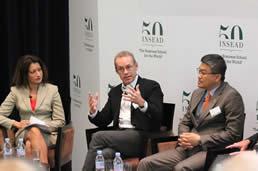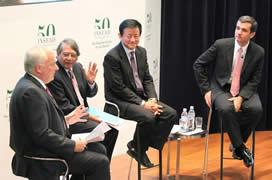
The secret weapon in the country’s arsenal is its tripartite approach involving the Ministry of Manpower (government), the National Trade Union Congress (labour) and the Singapore National Employers Federation (business).
“Tripartism in Singapore is something we take very seriously, because we believe that tripartism in fact, is one of the few unique advantages of Singapore,” said labour movement chief Lim Swee Say in the keynote dialogue the INSEAD Leadership Summit in Asia earlier this month.
When the crisis started late last year, Lim, who is also a minister in the Prime Minister’s office, revealed that the tripartite parties wasted no time in getting to work on how to mitigate the crisis which was unquestionably going to impact negatively on export-dependent Singapore.
With total job losses projected in the millions, global panic ensued and the stance that many countries took was to cut jobs to save costs.
“In Singapore, together (with the) tripartite partners, we made that collective commitment to each other, that we’re going to do it the other way around - we are going to cut costs to save jobs,” says Lim.
With that, the Jobs Credits Scheme was introduced in the Singapore Budget this year. Its objective - to preserve jobs in the downturn by providing incentives for businesses to retain existing workers. For every job saved, the government subsidises up to 12 per cent of an employee’s wages.
Lim reveals also that this was the first time that the government has ever dipped into the country’s large reserves, which he describes as “a lot”, to fund the scheme - to the tune of $4.5 billion.
The government also funded a Skills Programme for Upgrading and Resilience (SPUR), a financial support scheme developed in consultation with the tripartite partners. This retraining programme costs the government coffers “more than $5 billion”; it funds 90 per cent of training fees and absentee payrolls.
However, even with these measures in place, Lim says they are only stop-gap measures at best. The government has already decided to scale down the programme over the next six months, albeit gradually - from 12 per cent to nine, six per cent, and then be eventually phased out.
“This wage subsidy cannot be a long-term programme, because at the end of the day we must bite the bullet. The only way for Singapore to grow again -- the real long-term solution is for us to upgrade our productivity, our capability, our adaptability.”
Even as some analysts are declaring the recession officially over, Lim remains cautious. He describes the recovery as “uncertain” and “uneven,” and concurs that while the Singapore economy is “recovering quite nicely”, the government does not yet feel “comfortable.”
“Looking ahead at the next five to 10 years, we ask ourselves what is happening to the global economy. We believe that some global shift is already taking place. We believe that in the near future, there’s a global downside, caused by global unemployment.”
“As a result of this downturn, the world has changed. The better competitors are becoming cheaper; the cheaper competitors are becoming better ... The only way to move ahead is still to be cheaper, better and faster.”
With this, Lim believes the tripartite movement in Singapore is only going to gain more traction moving forward, especially when it has proven itself during the worst of times.
Conversely, he says the tripartite partners also need to remain relevant to the people it seeks to help in this new knowledge- and innovation-based economy which, he explains, is why membership of the National Trade Union Congress is all-encompassing and includes knowledge and older workers.
“We try to be as inclusive as we (can be), because it is only that way we can continue to remain relevant. (We are) also a labour movement for all ages of Singaporeans - young and old, and (of) all nationalities.” Some 20 per cent of its members are non-Singaporeans.
In defense of tripartism in Singapore, Lim says it must be seen from two angles. First, that tripartism in Singapore must be pro-business, because if it were not the case, then there would neither be investments nor jobs. Second, tripartism must be seen from the point of view that Singapore is not just an economy; Singapore is also a nation, so tripartism must also be pro-worker.
“These are two sides of the same coin, and that coin is a coin of nation-building. As a result, we are able to get through a downturn with minimum pain to businesses, to the workers, and yet at the same time when the upturn is back, we are among the first to be off the block because we have been investing and upgrading our capability during the downturn.”
-
View Comments
-
Leave a Comment




No comments yet.